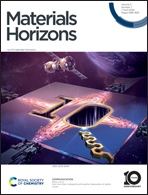A dual-responsive microemulsion with macroscale superlubricity and largely switchable friction†
Abstract
Although stimuli-responsive microemulsions (MEMs) consisting of water, oil and surfactants have found extensive potential applications in industrial fields, a responsive MEM exhibiting either macroscale superlubricity or two friction states where its coefficient of friction (CoF) can be switched by more than one order of magnitude has not yet been reported. Moreover, although traditional liquid superlubricants can provide ultralow friction and wear, effective control over the friction between two contacting surfaces is crucial for both achieving accurate control of the operation of an instrument and fabricating smart devices. Here we create a thermo- and magneto-responsive MEM capable of providing superlubrication for metallic materials in a broad temperature range from −30 to 20 °C using n-hexane, water, surfactant DDACe ((C12H25)2N+(CH3)2[CeCl4]−) and ethylene glycol. The MEM can abruptly and dramatically switch its CoF by approximately 25 fold based on a thermally reversible MEM-emulsion (EM) transition. Its anti-freezing performance allows it to provide effective lubrication even when the surrounding temperature attains as low as −60 °C. Together with its facile preparation, ultrahigh colloidal stability and magnetically controlled migration, such a novel smart MEM is envisioned to find widespread applications in materials science.

- This article is part of the themed collection: Materials Horizons 10th anniversary cover articles


 Please wait while we load your content...
Please wait while we load your content...